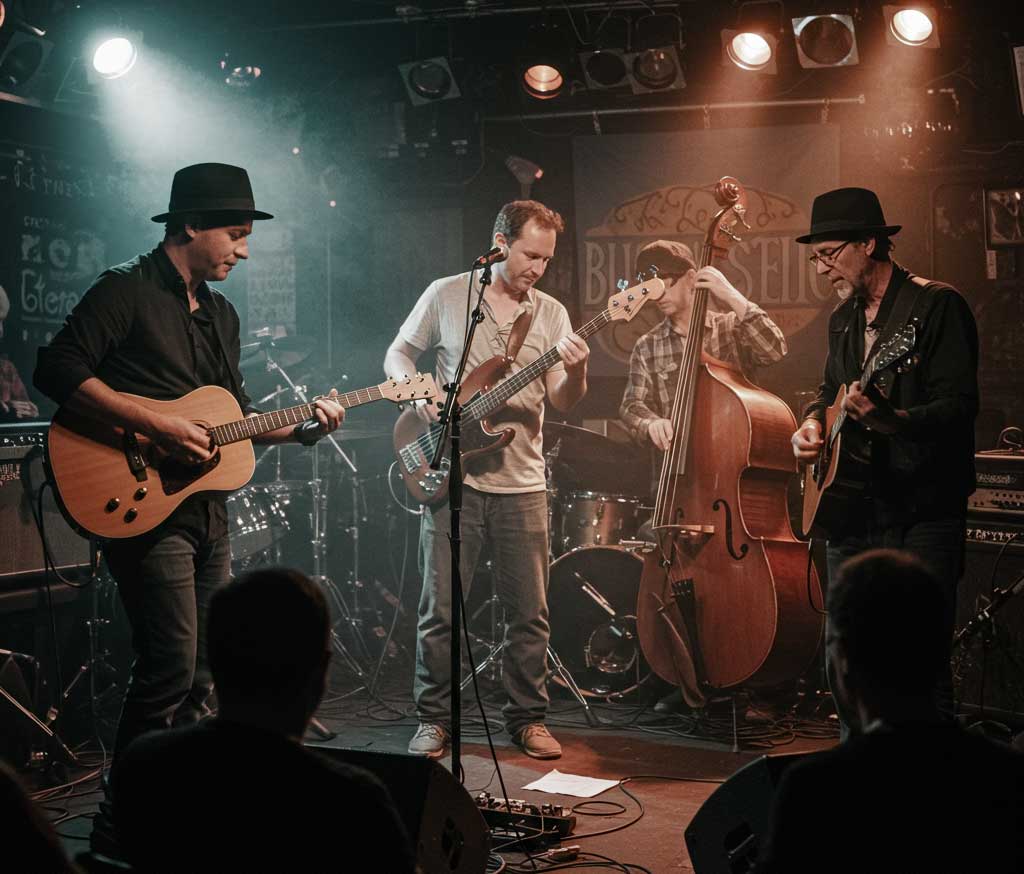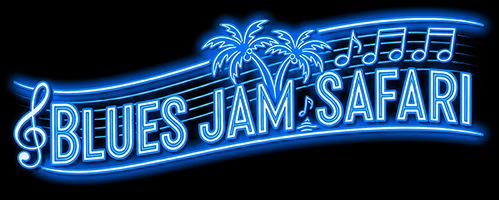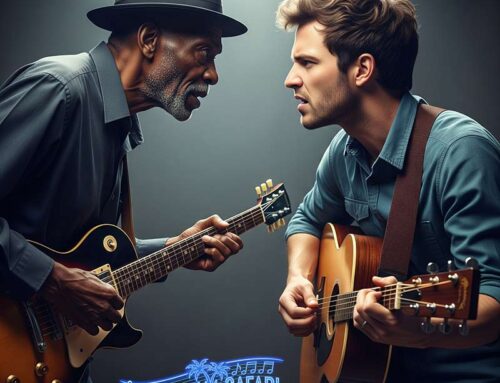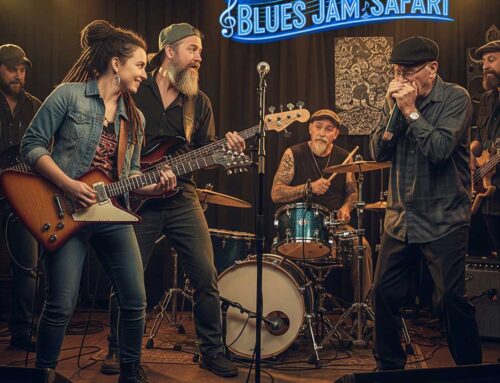More Than Just 12 Bars: Deconstructing the Blues Jam’s Musical Language
By: Richard Harvey
You walk into a smoky club, the air thick with anticipation. A band is on stage, laying down a groove, and then a guitarist steps up, someone you’ve never seen before. They nod, call out some instructions, and suddenly, everyone is playing together like they’ve rehearsed for weeks. It’s pure, unadulterated blues magic, with no charts or sheet music to guide them.
How do they do it? It’s not telepathy, though sometimes it feels that way. Instead, it’s the unspoken, deeply ingrained “musical language” of the blues jam—a system of common knowledge and subtle cues that allows strangers to coalesce into a cohesive unit in an instant.
At its core, much of blues music relies on the 12-bar blues progression. This fundamental “roadmap” underpins countless blues songs, being a repeating series of chords (typically the I, IV, and V chords of a key) over 12 measures. Grasping this basic structure allows you to follow along with almost any blues tune. The host or the singer will often simply call out the key, perhaps “Blues in E” or “Shuffle in A,” and from there, everyone instinctively understands the musical direction.
Beyond just chords, however, are the grooves—the rhythmic backbone that imparts each blues song its unique feel and pulse. A “shuffle” in E, for example, possesses a swinging, driving triplet feel that not only invites dancing but also propels the music forward with a rolling energy. This feels vastly different from a “slow blues” in G, which often adopts a more deliberate, emotional, and sometimes almost mournful 12/8 time signature, providing ample space for sustained notes and heartfelt expression. Then there’s the “rhumba” blues, or a “Latin” feel, that brings a different, often syncopated rhythm, adding a sultry or exotic flavor.
But the blues jam lexicon of grooves extends much further. You might encounter a “Chicago Shuffle,” a particularly propulsive and swinging variation of the shuffle often heard in the electric blues of the Windy City. Then there are more idiosyncratic rhythms like the “Flat tire” or “lumpity lump” groove, a slinky, slightly off-kilter shuffle that feels like it’s limping along in the most soulful way. Another classic is the “Linda Lu” groove, a driving, upbeat rock-and-roll blues rhythm, sometimes contrasted by a “backwards Linda Lu” which subtly reverses the rhythmic emphasis. A “tramp groove” offers a more laid-back, walking bass line feel, while the iconic “Bo Diddley” beat provides a syncopated, percussive pulse all its own. For those deeper, more earthy sounds, “Swamp Blues” evokes the humid, hypnotic rhythms of Louisiana, and “Jump Blues” or “West Coast Blues” brings a faster, horn-driven, and often more sophisticated swing. Experienced jammers instinctively recognize and adapt to these rhythmic feels, allowing the band to lock in immediately and create a cohesive sound. The drummer lays down the beat, the bassist finds the root and establishes the foundation, and the guitarists and keyboardists lay down chords that perfectly fit and enhance that particular groove.
Then, there’s the Stevie Shuffle, a distinctive guitar technique popularized by Stevie Ray Vaughan. SRV’s shuffle rhythm transcends a simple strumming pattern; it represents a complex, percussive, and deeply grooving approach to blues rhythm guitar. This sophisticated technique was instrumental in filling the sonic landscape of his trio, Double Trouble, with Chris Layton on drums and Tommy Shannon on bass. More than a mere stylistic choice, it became a defining characteristic that played a pivotal role in igniting a significant blues revival in the 1980s.
This shared rhythmic vocabulary is absolutely crucial for the spontaneous combustion that defines a truly great jam.
This seamless interaction extends to the communication, which is rarely verbal once the music begins. Instead, it manifests in the subtle lean of a shoulder, the tap of a foot, a pointed finger, or shared eye contact—cues that indicate, “Your turn to solo!” or “One more time around!” The song leader, or quarterback, dictates the flow, signaling when to transition between sections, With the rise and fall of the headstock, a guitarist can tell you when to hit a break or when the song is over.
However, when you find yourself in the position of calling the tune, it transforms into an experience akin to a quarterback calling a play. You must quickly and clearly communicate the entire roadmap to musicians who may have never played together before. This involves articulating the specific groove (e.g., “Texas shuffle”), the key (e.g., “in A”), and the desired tempo. You might also need to specify the turnaround (the chords played at the end of a 12-bar cycle that guide back to the beginning) or any particular breaks within the song’s structure. You’ll indicate the head (the main melodic theme) and precisely who will be taking the first solo that starts the tune.
Sometimes, a confident guitarist might “take the head” by starting alone on the V chord, with the band coming in on the I chord. Similarly, a harmonica player might kick things off by themselves on the I chord, clearly establishing the groove before the band joins on the IV. Crucially, you must signal when the band should enter after an introduction and definitively cue how the song will conclude—perhaps with a classic “cha-cha-cha” ending, a final decisive hit, a gentle fade-out, or a crowd favorite: The Big Ending, which builds energy to a loud crescendo and can go on forever.
For harmonica players in particular, a quick count out like “one, two, three, four” is often essential to ensure they start in perfect synchronization. This upfront communication meticulously sets the stage for the collective improvisation that is about to unfold.
The risk, of course, is that if you’re playing with a group of newbies, or with jammers from a different part of the world, these subtle cues might fly over their heads, leading to a choppy start. In such moments, when all else fails, the best advice is simply to keep playing until everyone finds their place in the sun, letting the inherent pull of the blues guide the way.
Ultimately, listening is paramount—truly listening to what everyone else is playing and finding your perfect space within it. It’s about support and collaboration, not merely showing off.
So, the next time you witness a blues jam, take a moment to appreciate the rich, dynamic conversation unfolding on stage. It’s a testament to the power of shared musical understanding, where every note and every silence plays an integral part in a story told through raw, collective improvisation. It’s a truly unique and thrilling experience, whether you’re actively playing or simply soaking it all in.






